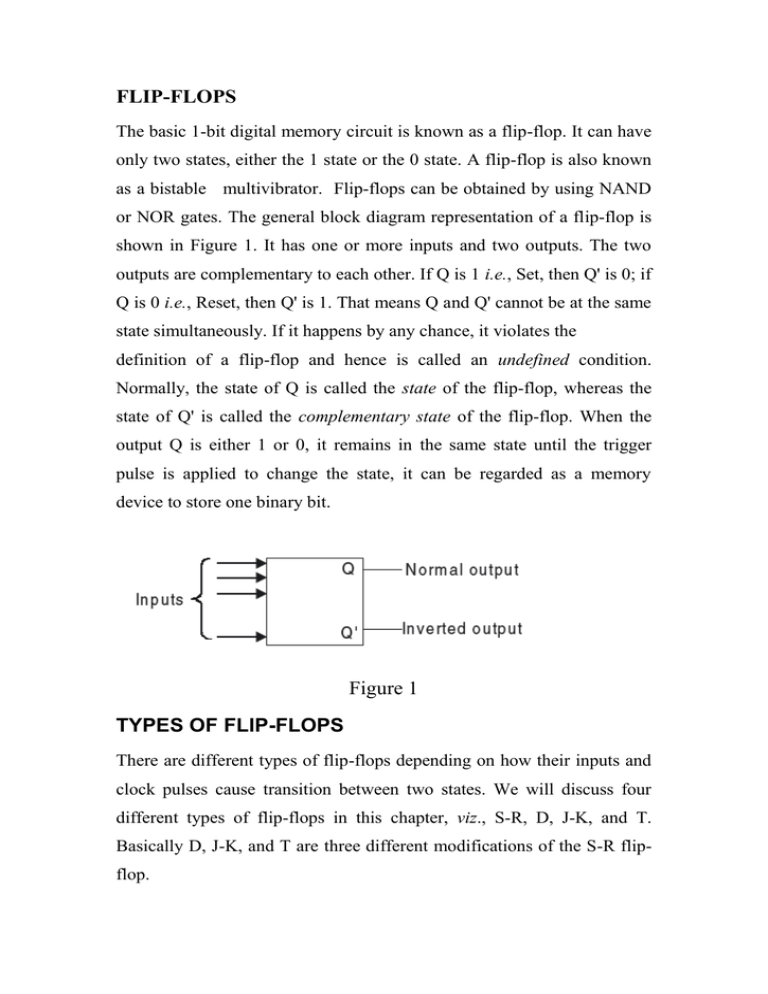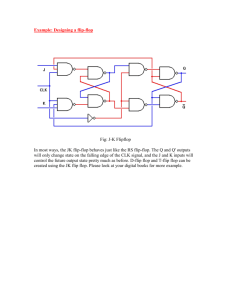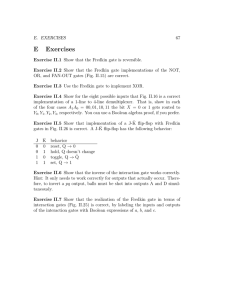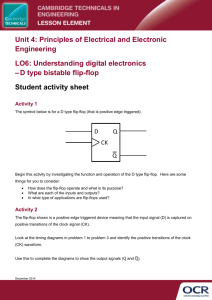FLIP-FLOPS
advertisement

FLIP-FLOPS The basic 1-bit digital memory circuit is known as a flip-flop. It can have only two states, either the 1 state or the 0 state. A flip-flop is also known as a bistable multivibrator. Flip-flops can be obtained by using NAND or NOR gates. The general block diagram representation of a flip-flop is shown in Figure 1. It has one or more inputs and two outputs. The two outputs are complementary to each other. If Q is 1 i.e., Set, then Q' is 0; if Q is 0 i.e., Reset, then Q' is 1. That means Q and Q' cannot be at the same state simultaneously. If it happens by any chance, it violates the definition of a flip-flop and hence is called an undefined condition. Normally, the state of Q is called the state of the flip-flop, whereas the state of Q' is called the complementary state of the flip-flop. When the output Q is either 1 or 0, it remains in the same state until the trigger pulse is applied to change the state, it can be regarded as a memory device to store one binary bit. Figure 1 TYPES OF FLIP-FLOPS There are different types of flip-flops depending on how their inputs and clock pulses cause transition between two states. We will discuss four different types of flip-flops in this chapter, viz., S-R, D, J-K, and T. Basically D, J-K, and T are three different modifications of the S-R flipflop. S-R (Set-Reset) Flip-flop An S-R flip-flop has two inputs named Set (S) and Reset (R), and two outputs Q and Q'. The outputs are complement of each other, i.e., if one of the outputs is 0 then the other should be 1. This can be implemented using NAND or NOR gates. The block diagram of an S-R flip-flop is shown in Figure 2 Figure 2 S-R Flip-flop Based on NOR Gates An S-R flip-flop can be constructed with NOR gates at ease by connecting the NOR gates back to back as shown in Figure 3. The crosscoupled connections from the output of gate 1 to the input of gate 2 constitute a feedback path. This circuit is not clocked and is classified as an asynchronous sequential circuit. The truth table for the S-R flip-flop based on a NOR gate is shown in the table in Figure 4. Figure 3 To analyze the circuit shown in Figure 3 , we have to consider the fact that the output of a NOR gate is 0 if any of the inputs are 1, irrespective of the other input. The output is 1 only if all of the inputs are 0. The outputs for all the possible conditions as shown in the table in Figure 4 are described as follows. Figure4 Case 1. For S = 0 and R = 0, the flip-flop remains in its present state (Qn). It means that the next state of the flip-flop does not change, i.e., Qn+1 = 0 if Qn = 0 and vice versa. First let us assume that Qn = 1 and Q'n = 0. Thus the inputs of NOR gate 2 are 1 and 0, and therefore its output Q'n+1 = 0. This output Q'n+1 = 0 is fed back as the input of NOR gate 1, thereby producing a 1 at the output, as both of the inputs of NOR gate 1 are 0 and 0; so Qn+1 = 1 as originally assumed. Now let us assume the opposite case, i.e., Qn = 0 and Q'n = 1. Thus the inputs of NOR gate 1 are 1 and 0, and therefore its output Qn+1 = 0. This output Qn+1 =0 is fed back as the input of NOR gate 2, thereby producing a 1 at the output, as both of the inputs of NOR gate 2 are 0 and 0; so Q'n+1 = 1 as originally assumed. Thus we find that the condition S = 0 and R = 0 do not affect the outputs of the flip-flop, which means this is the memory condition of the S-R flip-flop. Case 2. The second input condition is S = 0 and R = 1. The 1 at R input forces the output of NOR gate 1 to be 0 (i.e., Qn+1 = 0). Hence both the inputs of NOR gate 2 are 0 and 0 and so its output Q'n+1 = 1. Thus the condition S = 0 and R = 1 will always reset the flip-flop to 0. Now if the R returns to 0 with S = 0, the flip-flop will remain in the same state. Case 3. The third input condition is S = 1 and R = 0. The 1 at S input forces the output of NOR gate 2 to be 0 (i.e., Q'n+1 = 0). Hence both the inputs of NOR gate 1 are 0 and 0 and so its output Qn+1 = 1. Thus the condition S = 1 and R = 0 will always set the flip-flop to 1. Now if the S returns to 0 with R = 0, the flip-flop will remain in the same state. Case 4. The fourth input condition is S = 1 and R = 1. The 1 at R input and 1 at S input forces the output of both NOR gate 1 and NOR gate 2 to be 0. Hence both the outputs of NOR gate 1 and NOR gate 2 are 0 and 0; i.e., Qn+1 = 0 and Q'n+1 = 0. Hence this condition S = 1 and R = 1 violates the fact that the outputs of a flip-flop will always be the complement of each other. Since the condition violates the basic definition of flip-flop, it is called the undefined condition. Generally this condition must be avoided by making sure that 1s are not applied simultaneously to both of the inputs







